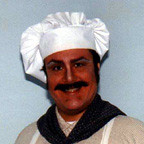Last week we finally got around to trying Yee Hwa, a place I've often walked by in the west end of downtown Washington. Located in the bottom of an office building, it has a large burgundy canopy going out to the curb and heavy curtains in the windows. The canopy and the windows are marked simply with the words "Yee Hwa" and the two Korean alphabet symbols for the same. Now, way over in Chinatown, there's a Texas-style barbecue joint, but I've always had the feeling that Yee Hwa ain't very Texan.
After going through a small entry hall and a second set of doors, one enters a sleekly contemporary dining room that turns out to be much larger inside than the establishment appears from the street. Along the left hand side of the dining room is a long cocktail bar that looks very much as though it used to be a sushi bar. Contemporary, wood-grained tables are separated by low glass dividers discreetly etched with the Korean "yee hwa" symbols. The menu indicates that Yee Hwa is a "Korean-Japanese" restaurant and that the Washington location is a branch of a restaurant in Seoul. They also have a separate menu with a lengthy list of sake and plum wines (some of which were very expensive!) and a handful of Korean and Japanese beers.
Even though the menu featured ribs and Korean barbecue, we decided to be less cowboy, and started with haemul pa jeon, a traditional Korean seafood and scallion pancake. The pancake started out as a very large oval on the grill, and once it was cooked to a slightly crispy, golden brown, it was fan-folded on to a large round plate and then cut into squares. It came with a dipping sauce with soy sauce, chives, and sesame seeds very similar to the sauce for Chinese dumplings. Since the rice flour used for the pancake has different cooking properties than wheat flour, the interior portions of the thin pancake had an interesting, almost "gooey" (yet cooked) consistency to it. We washed this down with a vase of hot "house" sake (the $8 kind, not the $100 kind).
For our main courses, we both opted for different forms of the popular Korean dish, bi bim bap (pronounced "bee-beem-bahp"). Bi bim bap, which means "mixed meal," is an artfully arranged bowl with a huge quantity of shredded vegetables. My bi bim bap was the plain, "simple," cold version with a large bowl of vegetables that included some unusual roots and fern sprouts all topped with a sunny-side up egg, and hot rice in a separate aluminum container. I had to add the special chile-based bi bim bap sauce to taste from a small bowl on the side, then mix up the vegetables, egg, rice, and sauce with a spoon and chopsticks.
My dinner companion had dolsot bi bim bap, which is the hot version that also includes beef. Its presentation is a little different. The bowl was a dark ceramic or stone dish made very hot on the stove. The rice was put directly into the bottom of dish, where the heat from the stone made the outer portions crunchy. With the addition of cooked beef, the rest of the entree was similar to mine with essentially the same vegetables and fried egg.
We were also given nine little bowls of complementary side dishes of various Korean vegetables. Most of these were in the kim-chee family (fermented cabbage with hot chiles...rotten cabbage is an acquired taste), but there were also some shredded white radishes, some preserved slices of what looked like candied jalapeño peppers, and some glossy red mung beans. The kim-chees included radishes and some pretty little slices of a thin cucumber. My friend tasted most of these things, especially the cabbage kim-chees, and thought they were good, but I'm allergic to something in kim-chee and I steer clear (as it was, I had indigestion and was queasy the whole next day, but this happens to me every time I go to a Korean place—I guess I just can't eat Korean food, which is a shame, since the food at Yee Hwa was tasty and elegantly presented).
At the end of the meal, our waitress brought us complimentary cups of Korean sweet rice punch. It's an interesting drink, which I think was non-alcoholic. It was amber in color with a water-like consistency and had a sweet taste scented with ginger. A few little pieces of what my friend said was chopped lotus root floated in the bottom.
Yee Hwa is a very nice restaurant with good food and a lot of amenities. I was surprised at how inexpensive our meal was (my bi bim bap was only $10), especially given the ambiance, quality of service, and complimentary food items. If you're a kim-chee fan, this is the place to go for Korean cuisine.
Monday, September 26, 2005
Subscribe to:
Post Comments (Atom)

No comments:
Post a Comment